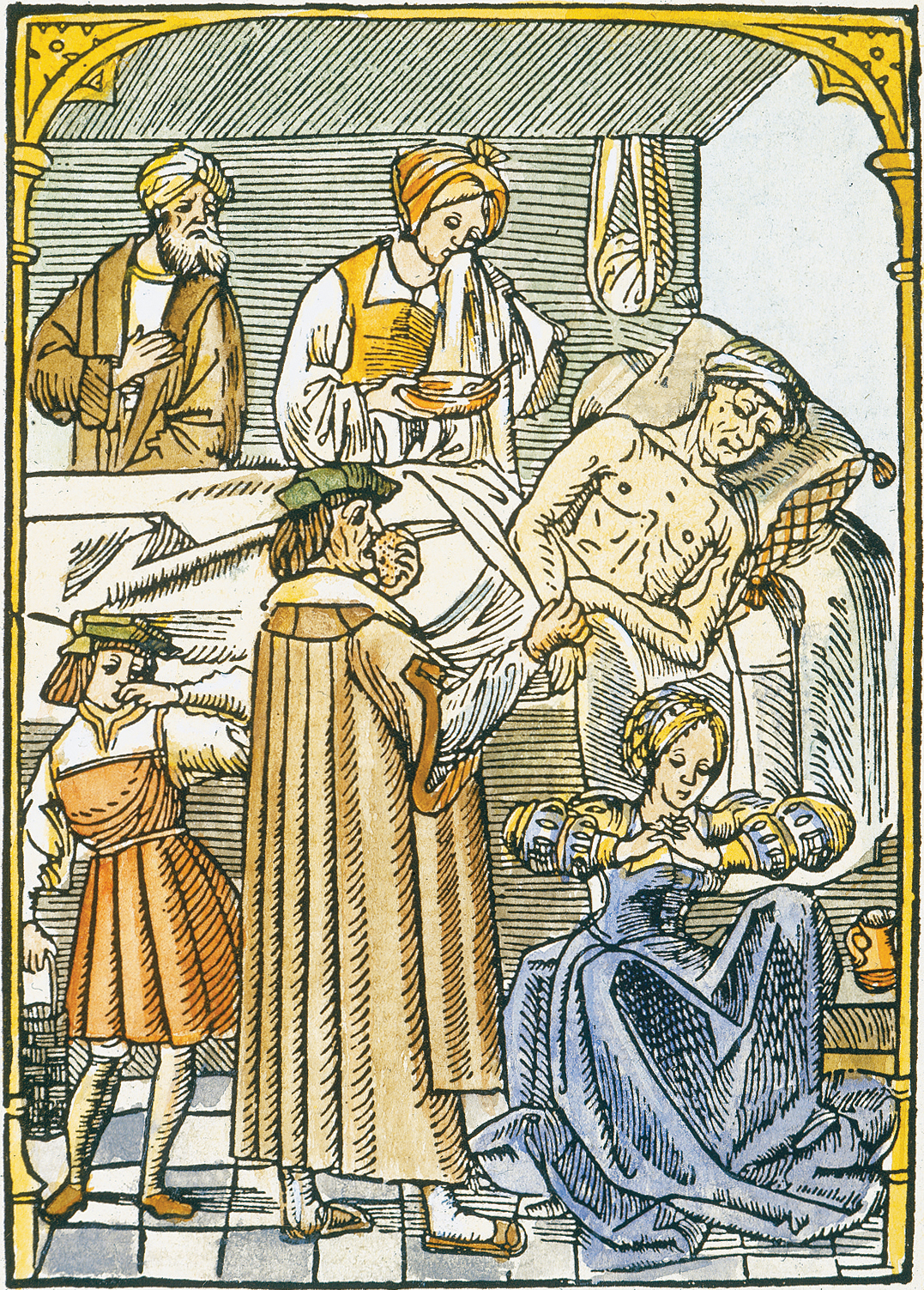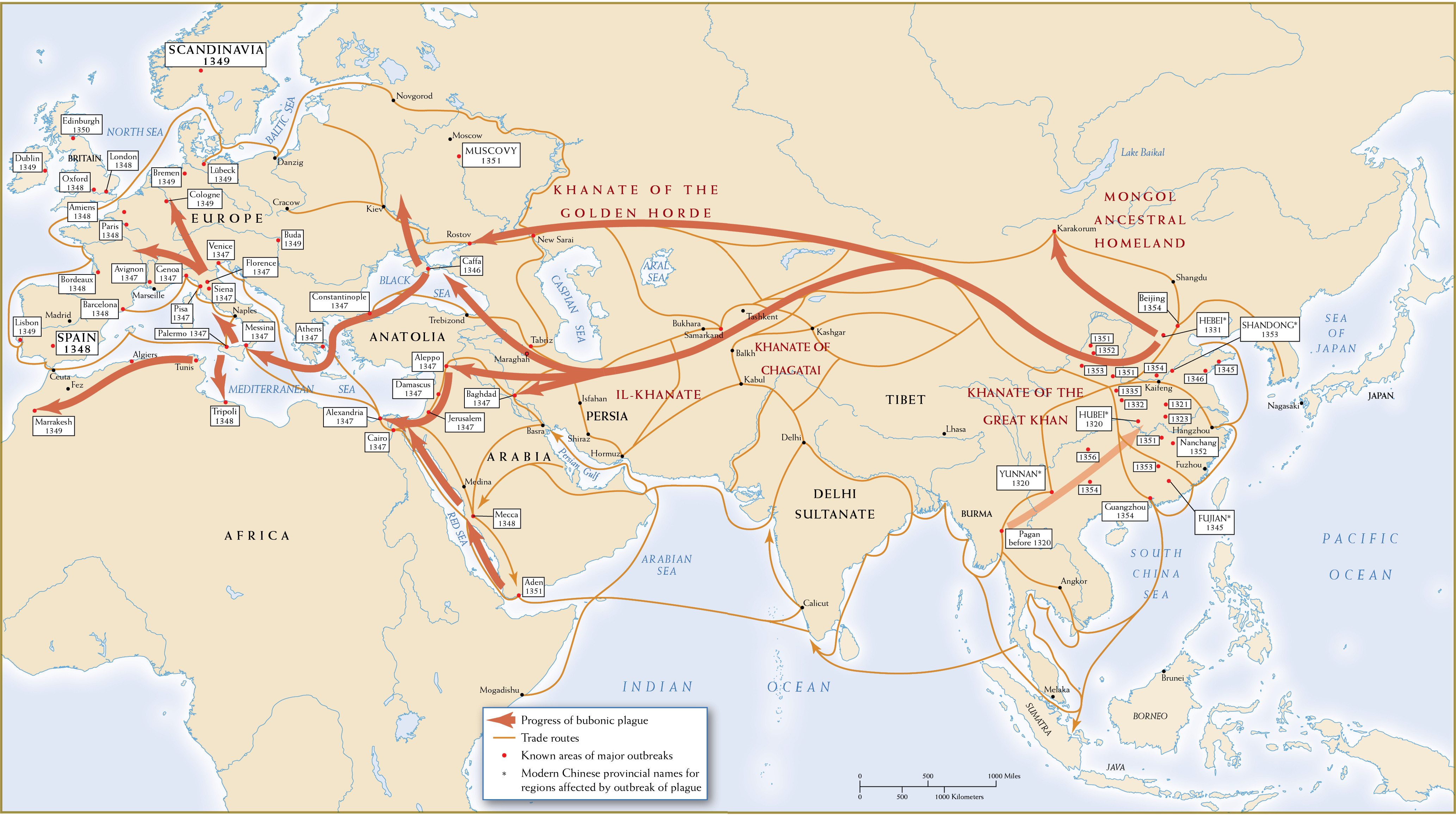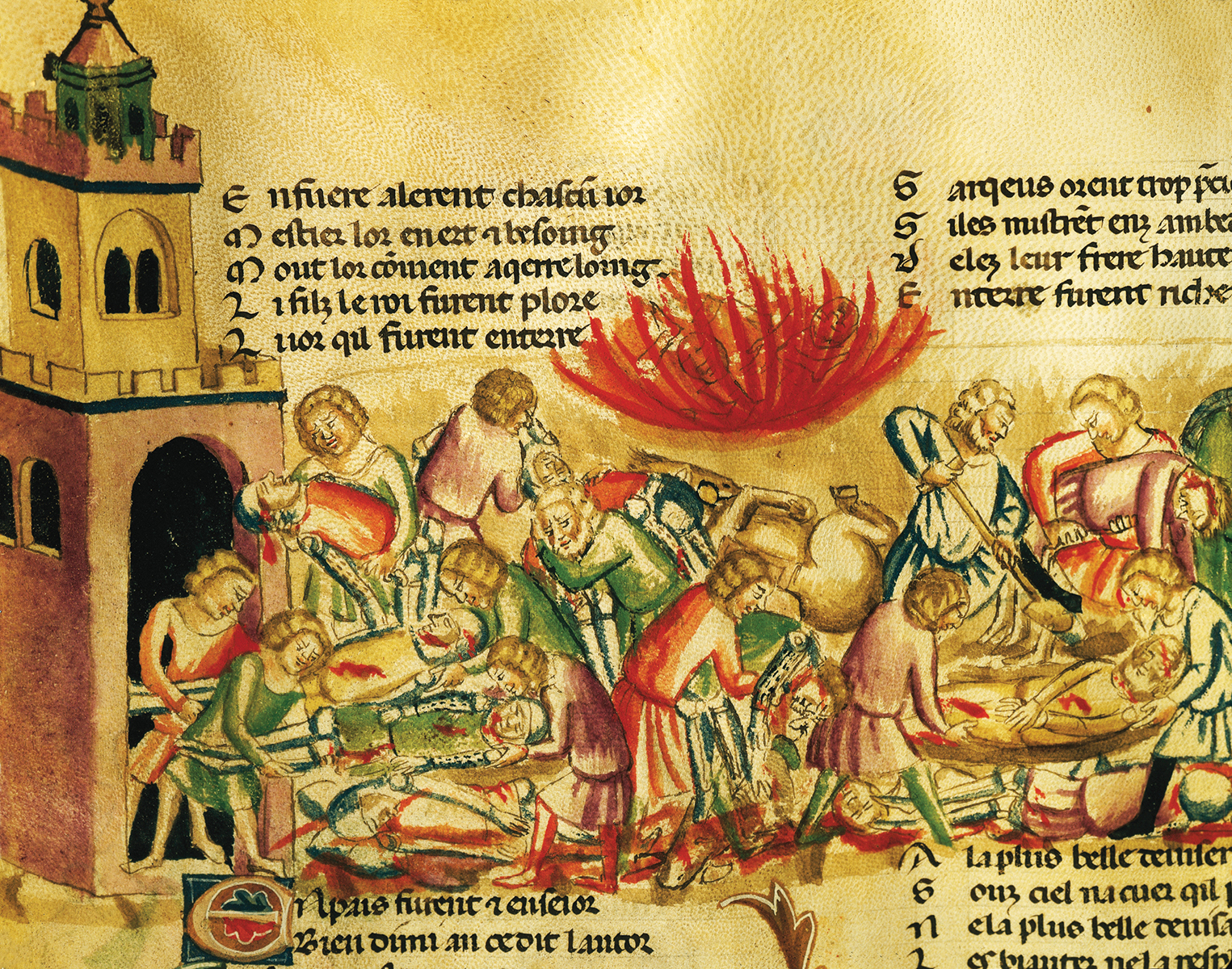THE BIG PICTURE
What crises affected fourteenth-century Afro-Eurasia and what was the range of responses to those crises?
THE BIG PICTURE
What crises affected fourteenth-century Afro-Eurasia and what was the range of responses to those crises?
Although the Mongol invasions overturned political systems, the plague devastated society itself. The pandemic killed millions, disrupted economies, and threw communities into chaos. Rulers could explain to their people the assaults of “barbarians,” but it was much harder to make sense of an invisible enemy. Nonetheless, in response to the upheaval, new ruling groups moved to reorganize their states. By making strategic marriages and building powerful armies, these rulers enlarged their territories, formed alliances, and built dynasties.
 The Black Death
The Black Death
The spread of the Black Death was the fourteenth century’s most significant historical development. (See Map 11.1.) Originating in Inner Asia, the disease afflicted peoples from China to Europe and killed 25 to 65 percent of infected populations.
How did the Black Death move so far and so fast? One explanation may lie in climate changes. The cooler climate of this period—scholars refer to a “Little Ice Age”—may have weakened populations and left them vulnerable to disease. In Europe, for instance, beginning around 1310, harsh winters and rainy summers shortened growing seasons and ruined harvests. Exhausted soils no longer supplied the resources required by growing urban and rural populations, while nobles squeezed the peasantry in an effort to maintain their luxurious lifestyle. The ensuing famine lasted from 1315 to 1322, during which time millions of Europeans died of starvation or of diseases against which the malnourished population had little resistance. Climate change and famine crippled populations on the eve of the Black Death. Climate change also spread drought across central Asia, where bubonic plague had lurked for centuries. So when steppe peoples migrated in search of new pastures and herds, they carried the germs with them and into contact with more densely populated agricultural communities. Rats also joined the exodus from the arid lands and transmitted fleas to other rodents, which then skipped to humans.
The resulting epidemic was terrifying, for its causes were unknown at the time. Infected victims died quickly—sometimes overnight—and in agony, coughing up blood and oozing pus and blood from black sores the size of eggs.
But it was the trading network that spread the germs across Afro-Eurasia into famine-struck western Europe. This wider Afro-Eurasian population was vulnerable because its members had no immunity to the disease. The first outbreak in a heavily populated region occurred in the 1320s in southwestern China. From there, the disease spread through China and then continued its death march along the major trade routes westward. Many of these routes terminated at the Italian port cities, where ships with dead and dying people aboard arrived in 1347. From there, what Europeans called the Pestilence or the Great Mortality engulfed the western end of the landmass. Societies in China, the Muslim world, and Europe suffered the disastrous effects of the Black Death.

Plague in China China was ripe for the plague pandemic. Its population had increased under the Song dynasty (960–1279) and subsequent Mongol rule. But by 1300, hunger and scarcity spread as resources were stretched thin. The weakened population was especially vulnerable. For seventy years, the Black Death ravaged China, reduced the size of the already small Mongol population, and shattered the Mongols’ claim to a mandate from heaven. In 1331, plague may have killed 90 percent of the population in Bei Zhili (modern Hebei) Province. From there it spread throughout other provinces, reaching Fujian and the coast at Shandong. By the 1350s, most of China’s large cities had suffered severe outbreaks.
Even as the Black Death was engulfing China, bandit groups and dissident religious sects were undercutting the power of the last Mongol Yuan rulers. Popular religious movements warned of impending doom. Most prominent was the Red Turban movement, which blended China’s diverse cultural and religious traditions, including Buddhism, Daoism, and other faiths. Its leaders emphasized strict dietary restrictions, penance, and ceremonial rituals and made proclamations that the world was drawing to an end.
Core Objectives
ASSESS the impact of the Black Death on China, the Islamic world, and Europe.
Plague in the Islamic World The plague devastated parts of the Muslim world as well. The Black Death reached Baghdad by 1347. By the next year, the plague overtook Egypt, Syria, and Cyprus, causing as many as 1,000 deaths a day according to a Tunisian report. Animals, too, were afflicted. One Egyptian writer commented: “The country was not far from being ruined. . . . One found in the desert the bodies of savage animals with the bubos under their arms. It was the same with horses, camels, asses, and all the beasts in general, including birds, even the ostriches.” In the eastern Mediterranean, plague left much of the Islamic world in a state of near political and economic collapse. The great Arab historian Ibn Khaldûn (1332–1406), who lost his mother and father and a number of his teachers to the Black Death in Tunis, underscored the desolation. “Cities and buildings were laid waste, roads and way signs were obliterated, settlements and mansions became empty, dynasties and tribes grew weak,” he wrote. “The entire world changed.”
Plague in Europe In Europe, the Black Death made landfall on the Italian Peninsula; then it seized France, the Netherlands, Belgium, Luxembourg, Germany, and England in its deathly grip. Overcrowded and unsanitary cities were particularly vulnerable. All levels of society—the poor, craftspeople, aristocrats—were at risk, although flight to the countryside offered some protection from infection. Nearly 50 million of Europe’s 80 million people perished between 1347 and 1351. After 1353, the epidemic waned, but the plague returned every seven years or so for the rest of the century and sporadically through the fifteenth century. Consequently, the European population continued to decline, until by 1450 many areas had only one-quarter the number of a century earlier.
In the face of the Black Death, some Europeans turned to debauchery, determined to enjoy themselves before they died. Others, especially in urban settings in Flanders, the Netherlands, and parts of Germany, claimed to find God’s grace outside what they saw as a corrupt Catholic Church. Semimonastic orders like the Beghards and Beguines, which had begun in the century or so before the plague, expanded in its wake. These laypeople (unordained men and women) argued that people should trust their own “interior instinct” more than the Gospel as then preached. By contrast, the Flagellants were so convinced that man had incurred God’s wrath that they whipped themselves to atone for human sin.
For many who survived the plague, disappointment with the clergy smoldered. Famished peasants resented priests and monks for living lives of luxury. In addition, they despaired at the absence of clergy when they were so greatly needed. While many clerics had perished attending to their parishioners during the Black Death, others had fled to rural retreats far from the ravages of the plague, leaving their followers to fend for themselves.
The Black Death wrought devastation throughout Afro-Eurasia. The Chinese population plunged from around 115 million in 1200 to 75 million or less in 1400, as the result of the Mongol invasions of the thirteenth century and the disease and disorder of the fourteenth century. Over the course of the fourteenth century, Europe’s population shrank by more than 50 percent. In the most densely settled Islamic territory—Egypt—a population that had totaled around 6 million in 1400 was cut in half. When farmers fell ill with the plague, food production collapsed. Famine followed and killed off the survivors. Worst afflicted were the crowded cities, especially coastal ports. Some cities lost up to two-thirds of their population. Refugees from urban areas fled their homes, seeking security and food in the countryside. The shortage of food and other necessities led to rapidly rising prices, work stoppages, and unrest. Political leaders added to their unpopularity by repressing the unrest. Everywhere, regimes trembled and collapsed. The Mongol Empire, which had held so much of Eurasia together commercially and politically, disintegrated. Thus, the way was prepared for experiments in state building, religious beliefs, and cultural achievements.

The Black Death was an Afro-Eurasian pandemic of the fourteenth century.

 “Good Laws and Good Arms”
“Good Laws and Good Arms”
Starting in the late fourteenth century, Afro-Eurasians began the task of reconstructing both their political order and their trading networks. By then the plague had died down, though it continued to afflict peoples for centuries. However, the rebuilding of military and civil administrations—no easy task—also required political legitimacy. With their people deeply shaken by the extraordinary loss of life, rulers needed to revive confidence in themselves and their regimes, which they did by fostering beliefs and rituals that confirmed their legitimacy and by increasing their control over subjects.
The basis for power was a political institution well known to Afro-Eurasians for centuries, the dynasty—the hereditary ruling family that passed control from one generation to the next. Like those of the past, the new dynasties sought to establish their legitimacy in three ways. First, ruling families insisted that their power derived from a divine calling: Ming emperors in China claimed for themselves what previous dynastic rulers had asserted—the “mandate of heaven”—while European monarchs claimed to rule by “divine right.” From their base in Anatolia, Ottoman warrior-princes asserted that they now carried the banner of Islam. In these ways, ruling households affirmed that God or the heavens intended for them to hold power. Second, leaders attempted to prevent squabbling among potential heirs by establishing clear rules about succession to the throne. Many European states tried to standardize succession by passing titles to the eldest male heir, thus ensuring political stability at a potential time of crisis, but in practice there were countless complications and quarrels. In the Islamic world, successors could be designated by the current ruler or elected by the community; here, too, struggles over succession were frequent. Third, ruling families elevated their power through conquest or alliance—by ordering armies to forcibly extend their domains or by marrying their royal offspring to rulers of other states or members of other elite households, a technique widely practiced in Europe. Once it established legitimacy, the typical royal family would consolidate power by enacting coercive laws and punishments and sending emissaries to govern distant territories. A ruling family would also establish standing armies and new administrative structures to collect taxes and to oversee building projects that proclaimed royal power.
As we will see in the next three sections of this chapter, the innovative state building that followed the plague’s devastating wake would not have been as successful had it not drawn on older traditions. The peoples of the Islamic world held fiercely to their religion as successor states, notably the Ottoman Empire, absorbed numerous Turkish-speaking groups. In Europe, a cultural flourishing based largely on ancient Greek and Roman models gave rise to thinkers who proposed new views of governance. The Ming renounced the Mongol expansionist legacy and emphasized a return to Han rulership, consolidating control of Chinese lands and concentrating on internal markets rather than overseas trade. Many of these regimes lasted for centuries, long enough to set deep roots for political institutions and cultural values that molded societies long after the Black Death.